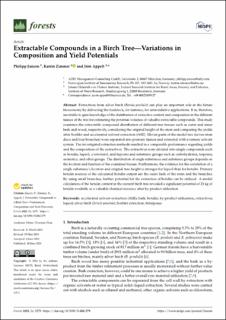| dc.description.abstract | Extractives from silver birch (Betula pendula) can play an important role in the future bioeconomy by delivering the feedstock, for instance, for antioxidative applications. It is, therefore, inevitable to gain knowledge of the distribution of extractive content and composition in the different tissues of the tree for estimating the potential volumes of valuable extractable compounds. This study examines the extractable compound distribution of different tree tissues such as outer and inner bark and wood, respectively, considering the original height of the stem and comparing the yields after Soxhlet and accelerated solvent extraction (ASE). Eleven parts of the model tree (seven stem discs and four branches) were separated into primary tissues and extracted with a ternary solvent system. The investigated extraction methods resulted in a comparable performance regarding yields and the composition of the extractives. The extractives were divided into single compounds such as betulin, lupeol, γ-sitosterol, and lupeone and substance groups such as carbohydrates, terpenes, aromatics, and other groups. The distribution of single substances and substance groups depends on the location and function of the examined tissues. Furthermore, the evidence for the correlation of a single substance’s location and original tree height is stronger for lupeol than for betulin. Primary betulin sources of the calculated betulin output are the outer bark of the stem and the branches. By using small branches, further potential for the extraction of betulin can be utilized. A model calculation of the betulin content in the current birch tree revealed a significant potential of 23 kg of betulin available as a valuable chemical resource after by-product utilization. | en_US |

